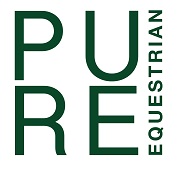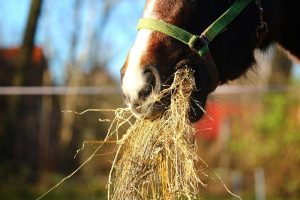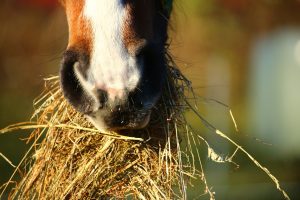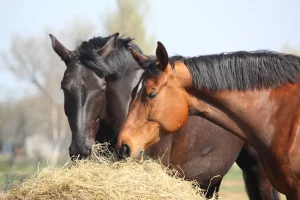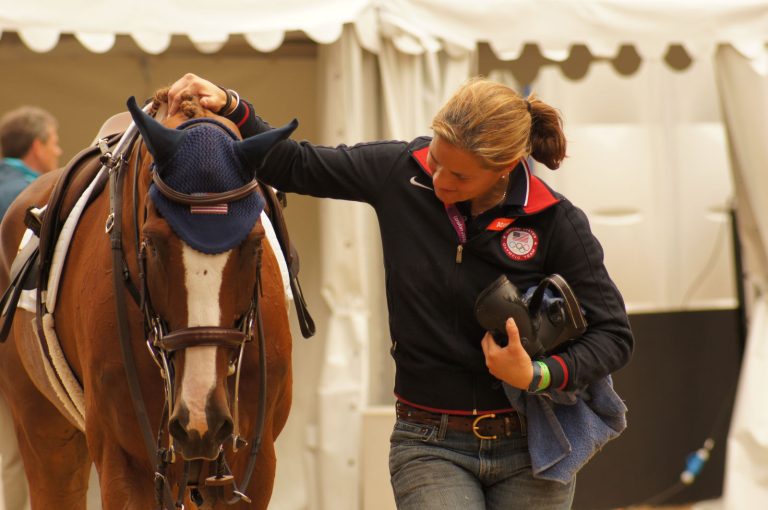Have you ever wondered how much hay a horse typically consumes in a day? If you’re a horse owner or simply curious about these elegant creatures, understanding their dietary needs is essential. This article will provide a fascinating insight into the daily hay consumption of horses, shed light on their nutritional requirements, and allow you to better care for these majestic animals. Get ready to discover just how much hay horses need to thrive and maintain their vitality. So, let’s dive into the world of equine nutrition and uncover the secrets of their hay consumption!
Table of Contents
ToggleFactors that Influence Hay Consumption
1. Horse Size and Weight
The size and weight of a horse directly influence the amount of hay it needs to consume. Larger horses typically require more hay than smaller ones. This is because their bodies require more energy to maintain their size and perform their daily activities. It is important to consider the size and weight of your horse when determining the appropriate amount of hay to feed.
2. Activity Level
The activity level of a horse also plays a significant role in determining its hay consumption. Horses that are highly active, such as those used for racing or competitive riding, have higher energy requirements and therefore need to consume more hay. On the other hand, horses that lead a sedentary lifestyle require less hay. It is important to assess the activity level of your horse and adjust its hay consumption accordingly.
3. Age and Nutritional Requirements
The age of a horse can greatly impact its nutritional requirements, which in turn affects its hay consumption. Growing foals and young horses have higher nutritional needs to support their development, and therefore require more hay. Older horses, on the other hand, may have special dietary needs due to dental issues or metabolism changes, and may require specially formulated hay or additional supplements. It is crucial to consider the age and nutritional requirements of your horse when determining its hay consumption.
4. Climate and Weather Conditions
The climate and weather conditions in which a horse is kept can also influence its hay consumption. Horses that are exposed to colder temperatures or harsh weather conditions have higher energy requirements to maintain their body temperature. These horses may need to consume more hay to meet their increased energy needs. Conversely, horses kept in warmer climates may have lower hay consumption due to a decreased need for insulation and energy production. It is important to take into account the climate and weather conditions when determining the appropriate amount of hay for your horse.
5. Access to Fresh Forage
Access to fresh forage, such as grass and pasture, can impact a horse’s hay consumption. Horses that have ample access to lush pasture may consume less hay as they are able to meet a portion of their dietary needs from grazing. On the other hand, horses that have limited access to pasture or are kept in areas with poor grazing conditions may rely more heavily on hay for their nutritional requirements. It is essential to consider your horse’s access to fresh forage when determining its hay consumption.
Recommended Hay Portions for Horses
1. General Guidelines
When it comes to feeding hay to horses, it is important to follow some general guidelines. As a general rule of thumb, horses should have access to at least 1.5% to 2% of their body weight in hay per day. This means that a 1,000-pound horse would require 15 to 20 pounds of hay daily. However, it is important to note that this is just a starting point, and the specific needs of your horse should be taken into consideration.
2. Feeding by Weight
One of the most accurate ways to determine the amount of hay to feed your horse is by calculating it based on their weight. Using a scale or weight tape, measure your horse’s weight and multiply it by 1.5% to 2% to determine the minimum and maximum amounts of hay they should consume. For example, a 1,200-pound horse would require between 18 and 24 pounds of hay daily.
3. Feeding by Volume
If weighing your horse or their hay is not feasible, another method is to feed by volume. This method involves measuring the amount of hay in a container, such as a flake or a scoop, rather than weighing it. A flake is equivalent to about 2-3 pounds of hay, so a horse that requires 15 to 20 pounds of hay would need approximately 5 to 8 flakes per day.
Determining the Right Amount of Hay for Your Horse
1. Consult with a Veterinarian or Equine Nutritionist
To determine the right amount of hay for your horse, it is always best to consult with a veterinarian or an equine nutritionist. They can assess your horse’s specific needs based on factors such as size, weight, activity level, age, and overall health. They can also provide specific guidelines and recommendations tailored to your horse’s individual needs.
2. Assess Your Horse’s Body Condition
Another way to determine the right amount of hay for your horse is by assessing their body condition. Body condition scoring involves evaluating your horse’s overall body fat distribution and muscle definition. Aim for a body condition score of 4-6 on a scale of 1-9, with 1 being extremely thin and 9 being obese. If your horse is too thin, they may require more hay to meet their energy needs. If they are overweight, they may need to consume less hay to promote weight loss.
3. Consider the Horse’s Diet and Forage Quality
In addition to considering your horse’s body condition and size, it is important to evaluate their overall diet and the quality of the forage available to them. If your horse has access to high-quality pasture or hay, they may require less supplemental hay. Conversely, if the forage available is of poorer quality, they may need to consume more hay to meet their nutritional needs. Take into account the overall diet and forage quality when determining the appropriate amount of hay for your horse.
4. Adjusting Hay Consumption over Time
It is important to understand that the right amount of hay for your horse may change over time. Factors such as changes in activity level, season, age, and health conditions can all impact hay consumption. Regularly assess your horse’s needs and make adjustments as necessary. Monitoring their weight, body condition, and overall health can help ensure they are receiving the appropriate amount of hay.
Common Mistakes to Avoid
1. Overfeeding Hay
One common mistake many horse owners make is overfeeding hay. While hay is an important part of a horse’s diet, excessive consumption can lead to weight gain, obesity, and related health issues. It is important to measure and monitor the amount of hay your horse receives to prevent overfeeding.
2. Underfeeding Hay
On the other hand, underfeeding hay can result in nutritional deficiencies and weight loss. Horses that do not receive enough hay may resort to eating dirt, chewing on wood, or displaying other undesirable behaviours. Ensure that your horse receives the appropriate amount of hay to meet their nutritional needs.
3. Ignoring Individual Needs
Each horse is unique and has specific nutritional requirements. Ignoring these individual needs can lead to suboptimal health and performance. Take the time to assess your horse’s specific needs and tailor their hay consumption accordingly. Consult with professionals if needed to ensure you are providing the best care for your horse.
4. Failing to Monitor Weight and Condition
Regularly monitoring your horse’s weight and body condition is crucial to ensure they are receiving the right amount of hay. Changes in weight or body condition may indicate that adjustments need to be made to their hay consumption. By regularly assessing their weight and condition, you can catch any issues early on and make the necessary changes to their diet.
Supplementing Hay with Other Feed
1. Introduction to Feed Balancers
In some cases, hay alone may not meet all of your horse’s nutritional requirements. This is where feed balancers come in. Feed balancers are specially formulated supplements that provide essential vitamins, minerals, and other nutrients lacking in hay or pasture. They can be particularly beneficial for horses on limited grazing or diets that consist primarily of hay.
2. Adding Concentrates or Grains
Concentrates or grains can also be added to supplement hay and provide additional energy and nutrients. However, it is important to carefully consider the specific needs of your horse and consult with a nutritionist or veterinarian before adding concentrates or grains. Improperly balanced diets can lead to digestive issues and other health problems in horses.
3. Providing Forage Alternatives
In some situations, it may be necessary to provide alternative sources of forage to supplement hay. This can include feeding haylage or silage, which are preserved forms of forage with higher moisture content. These alternatives can provide variety and additional nutrients to a horse’s diet. It is important to introduce new forage sources gradually and monitor your horse’s response to ensure they tolerate them well.
Storage and Handling Practices
1. Proper Hay Storage
Proper hay storage is essential to maintain its quality and prevent waste. Hay should be stored in a dry, well-ventilated area to prevent mould, moisture accumulation, and degradation of nutritional value. It should also be stored off the ground to avoid contact with moisture and pests. Bales should be stacked in a way that allows for airflow between them and minimises the risk of spontaneous combustion.
2. Avoiding Moulds and Contaminants
Moulds and contaminants can pose serious health risks to horses when present in hay. To avoid these issues, always inspect hay for signs of mould, dust, pests, or foreign objects before feeding it to your horse. Mouldy or spoiled hay should never be fed as it can lead to respiratory issues, colic, or other health problems. Purchase hay from reputable sources and store it properly to minimise the risk of contamination.
3. Slow Feeders and Hay Nets
Using slow feeders or hay nets can help prolong the eating time of your horse and mimic natural grazing behaviour. These feeding methods not only prevent hay wastage but also promote slower digestion and reduce the risk of digestive issues such as colic. Ensure that the size and design of the slow feeder or hay net are appropriate for your horse to prevent any potential hazards.
4. Consistency and Regularity
Maintaining a consistent and regular feeding schedule is important for horses. This helps promote healthy digestion, prevents boredom, and reduces the risk of behavioural issues. Feed hay at regular intervals throughout the day, ideally in smaller portions, to mimic a natural grazing pattern. Avoid sudden changes in hay type or quantity, as this can disrupt the horse’s digestive system.
Feeding Practices for Special Cases
1. Pregnant or Nursing Mares
Pregnant and nursing mares have increased nutritional needs to support the growth and development of their foals. Adequate amounts of high-quality hay should be provided to ensure they receive the necessary nutrients. Consult with a veterinarian or nutritionist to determine the specific requirements for your mare based on her stage of pregnancy or lactation.
2. Young Growing Horses
Young growing horses also have specific dietary needs to support their rapid growth and development. They require higher amounts of protein, minerals, and other nutrients compared to adult horses. In addition to high-quality hay, they may require specific supplements or concentrates. Consult with a veterinarian or nutritionist to develop an appropriate feeding plan for your young horse.
3. Senior Horses
Senior horses often experience dental issues that can make chewing hay difficult. In such cases, alternative sources of forage, such as hay cubes or soaked hay pellets, may be necessary. These options are easier to chew and digest, providing the necessary nutrients to older horses. Regular dental care and monitoring their body condition are crucial for the overall health and well-being of senior horses.
4. Horses with Health Conditions
Horses with specific health conditions, such as metabolic disorders or gastrointestinal issues, may require special diets and feeding practices. For example, horses with insulin resistance may need low-sugar hay or limited access to high-sugar pasture. Horses with gastrointestinal problems may benefit from small, frequent meals or specific types of hay to aid digestion. Consult with a veterinarian or equine nutritionist to develop a feeding plan that addresses your horse’s specific health needs.
Variations in Hay Consumption
1. Grass Hay versus Legume Hay
There are different types of hay available, with grass hay and legume hay being the most common. Grass hay, such as timothy or orchard grass, is generally lower in protein and energy compared to legume hay, such as alfalfa or clover. The nutritional composition can influence the amount of hay required. Horses fed legume hay may require less quantity due to the higher nutrient density.
2. Difference between Fresh and Dried Hay
Fresh hay refers to hay that has not undergone a drying process and is high in moisture content. Dried hay, on the other hand, has been properly cured and has a lower moisture content. Fresh hay is heavier due to the water content, so horses may consume more by weight. When comparing dried hay consumption to fresh hay, consider the difference in moisture content and adjust accordingly.
3. Seasonal Changes in Hay Intake
Hay consumption can also vary with seasonal changes. During the winter months, horses require more hay to meet their increased energy needs for maintaining body temperature. In contrast, during the summer when grazing is plentiful, horses may consume less hay. Adjusting hay intake based on seasonal changes is important to ensure your horse’s nutritional needs are met year-round.
Monitoring and Adjusting Hay Consumption
1. Regular Weighing and Body Condition Scoring
Regularly weighing your horse and conducting body condition scoring can help you monitor their hay consumption. By tracking changes in weight and body condition over time, you can determine if adjustments need to be made to their hay intake. Weighing and scoring should be done consistently to ensure accurate data and timely adjustments.
2. Observation of Eating Habits
Monitoring your horse’s eating habits can provide valuable insights into their hay consumption. Observe their feeding behaviour, including how much hay they consume and how quickly they finish it. Changes in eating habits, such as leaving more hay uneaten or consistently finishing it too quickly, may indicate a need to adjust the amount of hay provided.
3. Adjusting Hay Amounts Gradually
When making adjustments to your horse’s hay consumption, it is important to do so gradually. Abrupt changes in hay quantity can disrupt the digestive system and increase the risk of colic or other health issues. Instead, make small adjustments over time, allowing your horse’s digestive system to adapt to the change. Monitor their response and make further adjustments as needed.
Conclusion
Determining the appropriate amount of hay for your horse is a crucial aspect of their overall health and well-being. Factors such as horse size and weight, activity level, age, climate, and access to fresh forage all play a role in influencing hay consumption. By following general guidelines, consulting with professionals, and regularly monitoring your horse’s weight and condition, you can ensure they receive the right amount of hay for their individual needs. Avoid common mistakes, consider supplementation options when necessary, and practice proper storage and handling practices to maintain hay quality. By understanding the variations in hay consumption and monitoring your horse’s hay intake, you can provide optimal nutrition for their overall health and performance.
